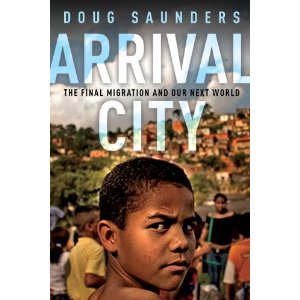 Doug Saunders
Doug Saunders2010
Doug Saunders, the European Bureau Chief for the Globe and Mail has written a very interesting book on migration. He looks at "Arrival Cities" across the globe: sometimes the migration is within a country, sometimes across the world. He says that "a third of the world's population is on the move this century, from village to city..." [21]. This is a huge transistion for our world. "In 1950, 309 million people in the developing world lived in cities; by 2030, 3.9 billion will. As of 2008, exactly half the world's 6.7 billion people lived in villages..." [21].
"Each month, there are five million new city-dwellers created through migration or birth in Africa, Asia and the Middle East. Between 2000 and 2030, the urban population of Asia and Africa will double, adding as many city-dwellers in one generation as these continents have accumulated during their entire histories. By the end of 2025, 60 per cent of the world will live in cities..." [22].
 Saunders, in contrast to many books on urbanization, paints an optimistic narrative about the future. While he is realistic about the difficulties of migrating to what he calls "Arrival Cities", at the same time he sees these communities as a bubbling soup from which new opportunities are born. Like Jane Jacobs's The Death and Life of Great American Cities, Saunders is optimistic about cities and human aspiration in the midst of overcrowded buildings and unplanned urban jungles. He argues that "high-intensity" living – overcrowding, in the words of most planners – is one of the keys to success in arrival cities.
Saunders, in contrast to many books on urbanization, paints an optimistic narrative about the future. While he is realistic about the difficulties of migrating to what he calls "Arrival Cities", at the same time he sees these communities as a bubbling soup from which new opportunities are born. Like Jane Jacobs's The Death and Life of Great American Cities, Saunders is optimistic about cities and human aspiration in the midst of overcrowded buildings and unplanned urban jungles. He argues that "high-intensity" living – overcrowding, in the words of most planners – is one of the keys to success in arrival cities.In fact, he argues that what we often see as perpetual slums are not that at all; rather, they are places where people are continually moving through the neighbourhood. He tells this story over and over again in different places.
Of particular interest to us close to Toronto, is his look at Thorncliffe Park, which while being one of the poorest neighbourhoods in Toronto, can also be viewed as "a successful antechamber to urban life" [314]. One of the paradoxes of arrival cities, is "the more successful they are, the higher their apparent poverty rate.... the neighbourhood will be continually refilled with new migrants from poor rural regions. It appears unchangingly poor and segregated only if you fail to observe the trajectory of each resident." [315]
Saunders calls the current people migration the most decisive social and cultural change since the Enlightenment and its legacies, including the French and Industrial revolutions. His argument is difficult to deny. The current urban migration is not just massive; it is, he argues, one-way, fast and final.
In all, if you are interested in the city, in our world, it is a book well worth taking a look at.
No comments:
Post a Comment